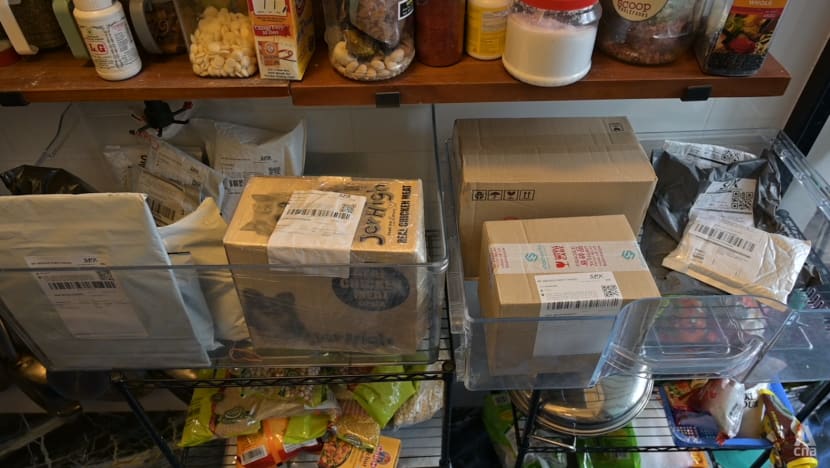Residential parcel collection points emerge as 'helpful' side hustles, but raise safety concerns
Online shoppers can opt to pick up their Shopee purchases at these collection points, to save on delivery fees.

Mr Srinivasan N keying in the details on the app for the recipient verification whilst running his Shopee residential collection point. (Photo: CNA/Hanidah Amin)

This audio is generated by an AI tool.
SINGAPORE: When Mr Srinivasan N first saw a Shopee parcel collection point at a convenience store in his neighbourhood last year, the 71-year-old wondered if he could also operate one from the comfort of his home.
The woman managing the store said he could - so he sent in an application to Shopee, and kicked off his residential collection point in March.
Neighbourhood parcel collection points were introduced in early 2023 by the e-commerce platform, starting with convenience stores and lockers.
They give Shopee customers the option to pick up their parcels and save money on delivery fees.
Shopee said these collection points are set up within a 250m proximity to most Singapore households.
But after households themselves expressed interest in becoming collection points, Shopee added them to the mix.
There are now over 2,000 collection points across shops, lockers and residences, though Shopee did not share the number of those located at households.
Hosts at these collection points can earn cash with each parcel distributed, and at least S$90 a month, according to promotional material from Shopee.
Neighbours of residential collection points told CNA they have benefited from easy access and savings in delivery costs, but some also raised security concerns due to the increased footfall outside their homes.
RUNNING A RESIDENTIAL COLLECTION POINT
Parcels will first be delivered to the collection point by Shopee. The homeowner then distributes them to customers after verifying their identity using Shopee's app.
Mr Srinivasan, who lives in a Housing Board flat in Punggol, still remembers his first pickup and how the responsibility dawned on him.
He started out with five to six parcels daily, but now averages about 15 to 20 parcels. During festive periods, those numbers can double or triple.

Hosting a collection point is not as simple as it looks, said Mr Srinivasan, who also works as a financial advisor and operates a food delivery business from his home.
For one, he needs to either be present at all times during opening hours, or ensure his home isn't unoccupied.
“When the customer approaches, you need to serve the customer. Very important. You cannot ignore it, you cannot make the person wait.”
He chooses to close his collection point from 1pm to 4pm to take a lunch break, shower or run errands.
Promotional material released by Shopee indicates an operational commitment of four weekdays and one weekend, with a minimum of eight hours a day.
However, hosts can request shorter hours based on their personal situations, and Shopee will assess these on a case-by-case basis.
The collection point also needs sufficient space to store parcels.
SOURCE OF SIDE INCOME
Other residential collection point hosts said they have benefited from the extra cash that has trickled in.
Ms Erra Haffiza started operating a residential collection point in April to supplement her income during her spare time at home.
The 21-year-old works as baggage check-in staff at a cruise centre for three days a week.
She said the Shopee collection point has also given her more time with her eight-month-old daughter.
“It would be impossible if I were to work another job with longer working hours,” said Ms Erra.
The extra earnings have also helped pay for her daughter’s daily needs such as diapers and milk powder.

Both Mr Srinivasan and Ms Erra did not want to reveal the amount of money they earned in a month.
According to information on Shopee’s app, collection points that distribute up to 900 parcels a day can earn up to S$5,400 monthly, while 60 parcels daily can bring S$360.
Mr Srinivasan said he signed up to also find some “sense of purpose” in his day-to-day.
“If somebody is going to think, ‘oh, it’s going to help me make tons of money’, then they are in the wrong place,” he said.
Ms Erra also pointed to intangible benefits such as a closer relationship with her neighbours.
“Ever since I got this Shopee collection point, I know more about my neighbours … surprisingly, I have quite a number of friendly neighbours,” she said.
She said those who regularly collect parcels from her HDB unit in Sengkang have struck up conversations with her, something which was never done before.
PROS AND CONS
People staying near Shopee residential collection points told CNA they mostly welcomed the convenience.
Junior college student Raphael Phan, for instance, said opting for Ms Erra’s collection point over doorstep delivery has saved him a bit of pocket money each week.
“If I go (to a collection point) five times, that can save me S$7, and that is like one meal, which is not bad,” said the 17-year-old, who lives a three-minute walk from Ms Erra.
Aircraft technician Hafiz Ismail, who lives in the next block to Mr Srinivasan, said the collection point has become his default with doorstep delivery “just getting too expensive”.
“It used to just be a few cents, but recently the highest was S$1.99,” said the 33-year-old.
But some neighbours living on the same floor as residential collection points also raised concerns about increased noise levels and more strangers walking past their homes.
A woman in her late 40s, who did not want to be identified, said she used to occasionally have larger items delivered to her doorstep.
Now, she worries they could be stolen.
“In the past, if I’m not at home, even if you leave it at my doorstep, I’m fine, because I know that nobody will pass by."
















